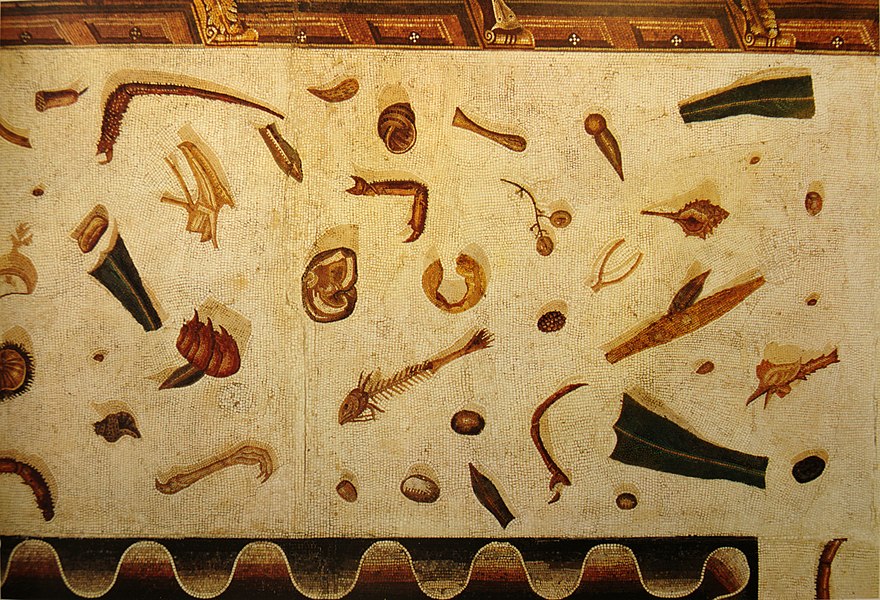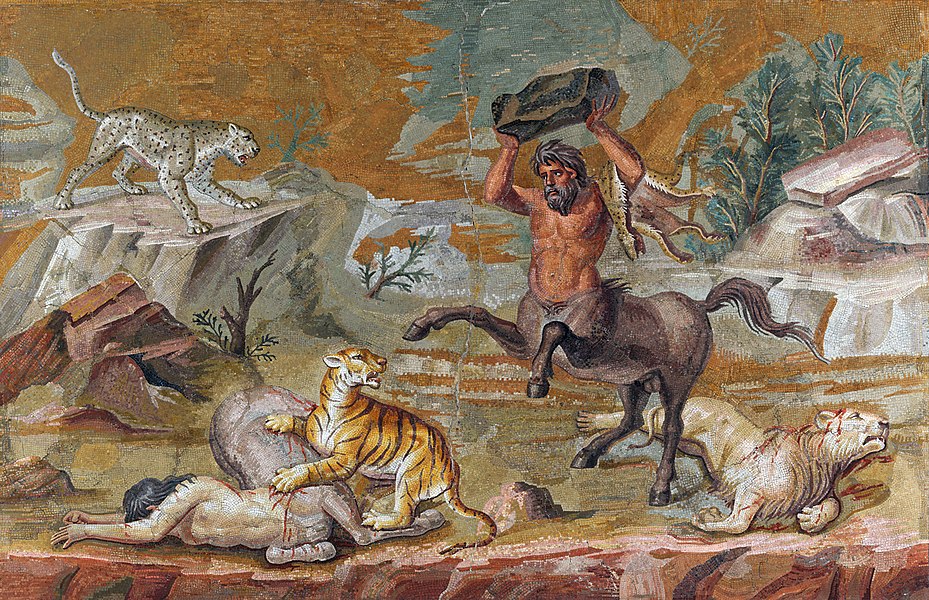 1
1title: Sátiro - Mosaico - Palazzo Massimo alle Terme - Roma
artist: <a rel="nofollow" class="external text" href="https://www.flickr.com/photos/31546678@N00">Lansbricae</a>
date: 2009-04-16 12:03:48
current location: Second floor :Museum:Palazzo Massimo
source: originally posted to '''[[Flickr|Flickr]]''' as [https://www.flickr.com/photos/31546678@N00/4122625917 Sátiro - Mosaico - Palazzo Massimo alle Terme - Roma]
credit: originally posted to <b><a href="//commons.wikimedia.org/wiki/Flickr" class="mw-redirect" title="Flickr">Flickr</a></b> as <a rel="nofollow" class="external text" href="https://www.flickr.com/photos/31546678@N00/4122625917">Sátiro - Mosaico - Palazzo Massimo alle Terme - Roma</a>
description: Pavement <u style="background-color:yellow;" class="">mosaic</u> with the head of a satyr. <u style="background-color:yellow;" class="">roman</u> artwork, Antonine period, 138–192 CE.
license:CC BY-SA 2.0
 2
2title: <div class="fn"> Roman mosaic (tessellated) pavement, London</div>
artist: unknown
source: https://wellcomeimages.org/indexplus/obf_images/17/bd/ce8a71b986137a1eff8cbc869791.jpg * Gallery: https://wellcomeimages.org/indexplus/image/L0038369.html * Wellcome Collection gallery (2018-04-02): https://wellcomecollection.org/works/txgn7qkd [https://creativecommons.org/licenses/by/4.0/ CC-BY-4.0]
credit: <p><a rel="nofollow" class="external free" href="https://wellcomeimages.org/indexplus/obf_images/17/bd/ce8a71b986137a1eff8cbc869791.jpg">https://wellcomeimages.org/indexplus/obf_images/17/bd/ce8a71b986137a1eff8cbc869791.jpg</a> </p> <ul> <li>Gallery: <a rel="nofollow" class="external free" href="https://wellcomeimages.org/indexplus/image/L0038369.html">https://wellcomeimages.org/indexplus/image/L0038369.html</a> </li> <li>Wellcome Collection gallery (2018-04-02): <a rel="nofollow" class="external free" href="https://wellcomecollection.org/works/txgn7qkd">https://wellcomecollection.org/works/txgn7qkd</a> <a rel="nofollow" class="external text" href="https://creativecommons.org/licenses/by/4.0/">CC-BY-4.0</a> </li> </ul>
description: <div class="description"> <p>Lithographic reproduction showing a fragment of a <u style="background-color:yellow;" class="">roman</u> tessellated pavement discovered under the French Protestant Church in Threadneedle Street in the City of London, April 1841. The fragment features floral and knot designs. </p> <p>Rare Books<br> Keywords: Tiles; Antiquity; <u style="background-color:yellow;" class="">roman</u>; London; J. Basire; Archaeology; <u style="background-color:yellow;" class="">mosaic</u></p> </div>
license:CC BY 4.0
 3
3title: Colombes, mosaïque romaine
artist: <div class="fn value"> <bdi lang="">Unknown author</bdi> </div>
date: end of 2nd century CE
source: from ''Le Musée absolu'', Phaidon, 10-2012
credit: from <i>Le Musée absolu</i>, Phaidon, 10-2012
description: <u style="background-color:yellow;" class="">mosaic</u> emblema with doves. <u style="background-color:yellow;" class="">roman</u> copy after an Pergamenian original from the 2nd century BCE. Villa of Emperor Hadrian, Tivoli, Italy. 85 x 98 cm.
license:Public domain
 4
4title: Mosaïque de Dionysos
artist: <div class="fn value"> <bdi lang="">Unknown author</bdi> </div>
date: 2<sup>nd</sup> century <a href="https://en.wikipedia.org/wiki/en:Ante_Christum_Natum" class="extiw" title="w:en:Ante Christum Natum">BC</a> <div style="display: none;">date QS:P571,-150-00-00T00:00:00Z/7</div>
source: from ''Le Musée absolu'', Phaidon, 10-2012
credit: from <i>Le Musée absolu</i>, Phaidon, 10-2012
description: Central panel from a tesselated floor of a <u style="background-color:yellow;" class="">roman</u> villa depicting Dionysos with fruit and ivy in his hair, second half 2nd Century AD, Archaeological Museum of Ancient Corinth, Greece. 2.6 x 2.6 m.
license:Public domain
 5
5title: Restes du banquet, mosaïque
artist: <div class="fn value"> Herakleitos, from Sosus of Pergamon</div>
date: beginning of 2nd CE
source: from ''Le Musée absolu'', Phaidon, 10-2012
credit: from <i>Le Musée absolu</i>, Phaidon, 10-2012
description: Banquet leftovers, or <i>Unswept Floor</i>, <u style="background-color:yellow;" class="">mosaic</u>. Inspired by Sosus of Pergamon, Museum Gregoriano Profano, Vatican. 4.05 x 0.41 m.
license:Public domain
 6
6title: Transport d'animaux exotiques, villa de Casale, Piazza Armerina, Sicile, Italie
artist: <div class="fn value"> <bdi lang="">Unknown author</bdi> </div>
date: middle of 4th century CE
source: from ''Le Musée absolu'', Phaidon, 10-2012
credit: from <i>Le Musée absolu</i>, Phaidon, 10-2012
description: Exotic animal transportation, Villa del Casale, Piazza Armerina, Sicily, Italy. Rare scene of two separate events on a single tableau, a common narrative technique in <u style="background-color:yellow;" class="">roman</u> visual arts.
license:Public domain
 7
7title: Memento Mori mosaic (from Pompeii)
artist: <div class="fn value"> <bdi lang="">Unknown author</bdi> </div>
date: 1<sup>st</sup> century <a href="https://en.wikipedia.org/wiki/en:Ante_Christum_Natum" class="extiw" title="w:en:Ante Christum Natum">BC</a> <div style="display: none;">date QS:P571,-050-00-00T00:00:00Z/7</div>
source: Own
description: <u style="background-color:yellow;" class="">roman</u> <u style="background-color:yellow;" class="">mosaic</u> representing the Wheel of Fortune which, as it turns, can make the rich (symbolized by the purple cloth on the left) poor and the poor (symbolized by the goatskin at right) rich; in effect both states are very precarious, with death never far and life hanging by a thread: when it breaks, the soul (symbolized by the butterfly) flies off. And thus are all made equal.
license:Public domain
 8
8title: <div class="fn"> <span ><span dir="ltr" lang="en"><i>Virgil mosaic</i></span></span><div style="display: none;">label QS:Lfr,"mosaïque de Virgile"</div> <div style="display: none;">label QS:Len,"Virgil mosaic"</div> </div>
artist: <div class="fn value"> <bdi lang="">Unknown artist</bdi> </div>
date: 3<sup>rd</sup> century <div style="display: none;">date QS:P,+250-00-00T00:00:00Z/7</div> <a href="https://www.wikidata.org/wiki/Q3324689#P571" title="Edit this at Wikidata"><img alt="Edit this at Wikidata" src="https://upload.wikimedia.org/wikipedia/commons/thumb/8/8a/OOjs_UI_icon_edit-ltr-progressive.svg/10px-OOjs_UI_icon_edit-ltr-progressive.svg.png" decoding="async" width="10" height="10" style="vertical-align: text-top" srcset="https://upload.wikimedia.org/wikipedia/commons/thumb/8/8a/OOjs_UI_icon_edit-ltr-progressive.svg/15px-OOjs_UI_icon_edit-ltr-progressive.svg.png 1.5x, https://upload.wikimedia.org/wikipedia/commons/thumb/8/8a/OOjs_UI_icon_edit-ltr-progressive.svg/20px-OOjs_UI_icon_edit-ltr-progressive.svg.png 2x" data-file-width="20" data-file-height="20"></a>
source: “Roman Art,” Encyclopædia Britannica (11th ed.), v. 23, 1911, Plate VI facing p. 484, fig. 31.
credit: “Roman Art,” Encyclopædia Britannica (11th ed.), v. 23, 1911, Plate VI facing p. 484, fig. 31.
description: Ancient <u style="background-color:yellow;" class="">roman</u> <u style="background-color:yellow;" class="">mosaic</u> depicting Virgil flanked by two figures (muses?).
license:Public domain
 9
9title: <div class="fn"> <span ><span dir="ltr" lang="en"><i>Centaur mosaic</i></span></span><div style="display: none;">title QS:P1476,en:"Centaur mosaic"</div> <div style="display: none;">label QS:Len,"Centaur mosaic"</div> </div>
artist: <div class="fn value"> Unknown<br><a rel="nofollow" class="external text" href="http://www.googleartproject.com/artist/unknown/4128544/">Details of artist on Google Art Project</a> </div>
date: (120 - 130)
dimensions: w915 x h585 cm
current location: Altes Museum, Staatliche Museen zu Berlin
credit: <p><a rel="nofollow" class="external text" href="//www.google.com/culturalinstitute/asset-viewer/SwHAQhNGz6l7_Q">SwHAQhNGz6l7_Q at Google Cultural Institute</a> zoom level scaled </p> down from maximum resolution
description: The centaur <u style="background-color:yellow;" class="">mosaic</u> was found in the 18th century on the site of the sprawling, luxurious villa complex near Tivoli that once belonged to the <u style="background-color:yellow;" class="">roman</u> emperor Hadrian. The <u style="background-color:yellow;" class="">mosaic</u> was found in situ along with other smaller ones that bore depictions of landscapes, animals and masks. The relatively small central panel (emblema) formed part of the floor decoration for the dining room (triclinium) in the main palace. The various individual scenes of these <u style="background-color:yellow;" class="">mosaic</u> pictures bear depictions of wild, inhospitable landscapes that deliberately contrast with idyllic ones featuring animals living in harmony with each other. The dangers of the wild are portrayed in this <u style="background-color:yellow;" class="">mosaic</u> in the dramatic struggle between great cats and a pair of centaurs, mythological creatures with the head, arms, and torso of a man and the body and legs of a horse. On a rocky outcrop that hangs over a terrific chasm that runs parallel to the bottom of the picture, a pair of centaurs have been pounced on by great cats. While the male centaur has been able to defend itself successfully from the lion, the tiger has managed to bring the female centaur to the ground and is clawing her side. The male centaur rushes to his companion’s side, rearing his legs in the air while holding a rock aloft above his head. Undaunted, the tiger seems intent on not surrendering its prey. Even though one lion already lies fatally wounded, bleeding and with its claws retracted, the outcome of the struggle is anything but clear because in the background (whose spatial depth is achieved through the staggered arrangement of rock forms and impressive gradations of colour) we see yet another foe for the centaur: a leopard ready to pounce. While depictions in older Greek art tended to emphasise the bestial side of centaurs, later depictions increasingly focussed on their human qualities. Lucian, a writer from the 2nd century, records that the Greek painter Zeuxis (active around 400 BCE) became famous for his painting of a family of centaurs, including the young, set in a rural idyll. Similarly, Ovid, who lived around the turn of the millennium, wrote in moving verse of the death of a centaur couple. The extensive restoration work that was undertaken in the 18th and 19th century makes it difficult to date the <u style="background-color:yellow;" class="">mosaic</u> with certainty. As a result, its dating ranges from Hellenistic to Hadrianic. There is broad agreement among scholars that the <u style="background-color:yellow;" class="">mosaic</u> amounts to one of most virtuoso works of <u style="background-color:yellow;" class="">roman</u> <u style="background-color:yellow;" class="">mosaic</u> art, which was inspired by a Greek work of art (either a panel painting or <u style="background-color:yellow;" class="">mosaic</u>) from the Hellenistic period.
license:Public domain
 10
10title: <div class="fn"> <span ><span dir="ltr" lang="en"><i>Centaur mosaic</i></span></span><div style="display: none;">title QS:P1476,en:"Centaur mosaic"</div> <div style="display: none;">label QS:Len,"Centaur mosaic"</div> </div>
artist: <div class="fn value"> Unknown<br><a rel="nofollow" class="external text" href="http://www.googleartproject.com/artist/unknown/4128544/">Details of artist on Google Art Project</a> </div>
date: (120 - 130)
dimensions: w915 x h585 cm
current location: Altes Museum, Staatliche Museen zu Berlin
credit: <a rel="nofollow" class="external text" href="//www.google.com/culturalinstitute/asset-viewer/SwHAQhNGz6l7_Q">SwHAQhNGz6l7_Q at Google Cultural Institute</a> maximum zoom level
description: The centaur <u style="background-color:yellow;" class="">mosaic</u> was found in the 18th century on the site of the sprawling, luxurious villa complex near Tivoli that once belonged to the <u style="background-color:yellow;" class="">roman</u> emperor Hadrian. The <u style="background-color:yellow;" class="">mosaic</u> was found in situ along with other smaller ones that bore depictions of landscapes, animals and masks. The relatively small central panel (emblema) formed part of the floor decoration for the dining room (triclinium) in the main palace. The various individual scenes of these <u style="background-color:yellow;" class="">mosaic</u> pictures bear depictions of wild, inhospitable landscapes that deliberately contrast with idyllic ones featuring animals living in harmony with each other. The dangers of the wild are portrayed in this <u style="background-color:yellow;" class="">mosaic</u> in the dramatic struggle between great cats and a pair of centaurs, mythological creatures with the head, arms, and torso of a man and the body and legs of a horse. On a rocky outcrop that hangs over a terrific chasm that runs parallel to the bottom of the picture, a pair of centaurs have been pounced on by great cats. While the male centaur has been able to defend itself successfully from the lion, the tiger has managed to bring the female centaur to the ground and is clawing her side. The male centaur rushes to his companion’s side, rearing his legs in the air while holding a rock aloft above his head. Undaunted, the tiger seems intent on not surrendering its prey. Even though one lion already lies fatally wounded, bleeding and with its claws retracted, the outcome of the struggle is anything but clear because in the background (whose spatial depth is achieved through the staggered arrangement of rock forms and impressive gradations of colour) we see yet another foe for the centaur: a leopard ready to pounce. While depictions in older Greek art tended to emphasise the bestial side of centaurs, later depictions increasingly focussed on their human qualities. Lucian, a writer from the 2nd century, records that the Greek painter Zeuxis (active around 400 BCE) became famous for his painting of a family of centaurs, including the young, set in a rural idyll. Similarly, Ovid, who lived around the turn of the millennium, wrote in moving verse of the death of a centaur couple. The extensive restoration work that was undertaken in the 18th and 19th century makes it difficult to date the <u style="background-color:yellow;" class="">mosaic</u> with certainty. As a result, its dating ranges from Hellenistic to Hadrianic. There is broad agreement among scholars that the <u style="background-color:yellow;" class="">mosaic</u> amounts to one of most virtuoso works of <u style="background-color:yellow;" class="">roman</u> <u style="background-color:yellow;" class="">mosaic</u> art, which was inspired by a Greek work of art (either a panel painting or <u style="background-color:yellow;" class="">mosaic</u>) from the Hellenistic period.
license:Public domain





